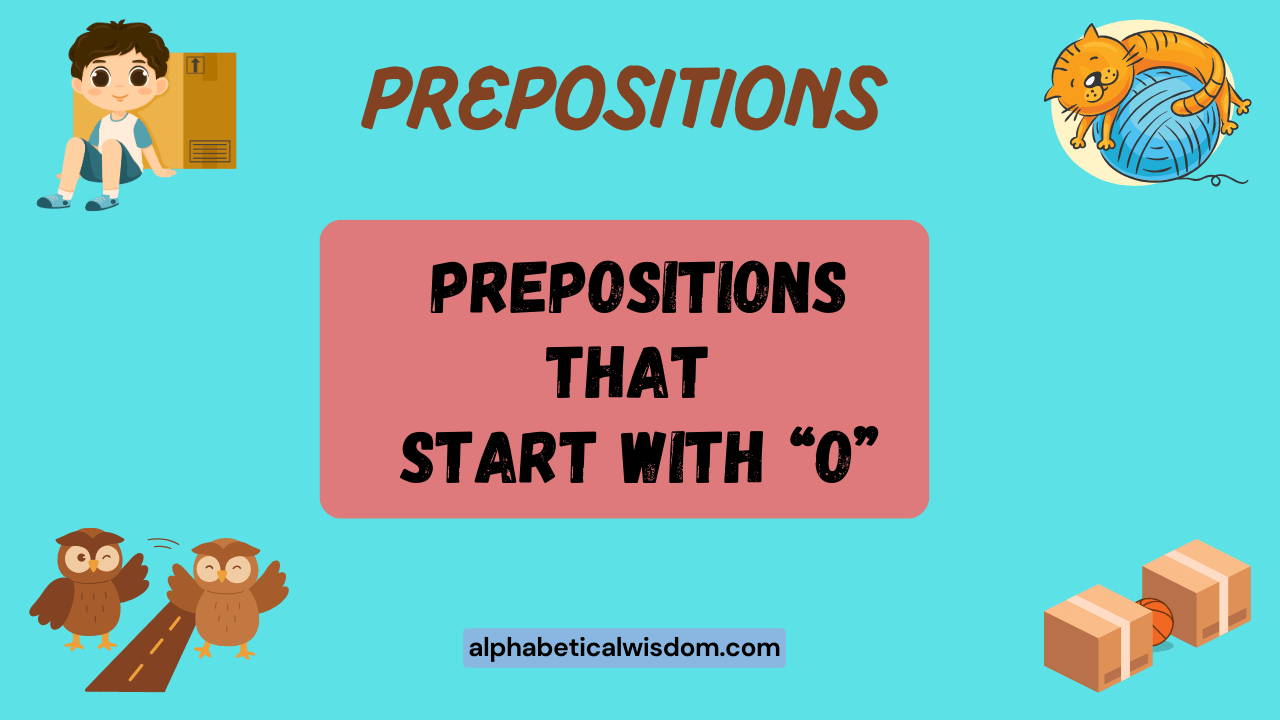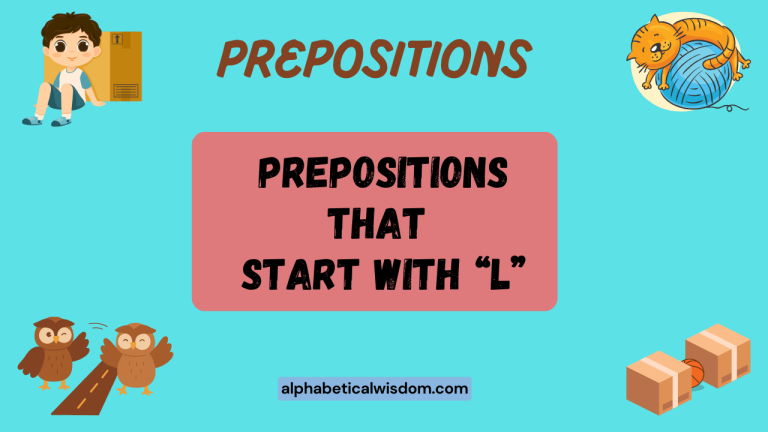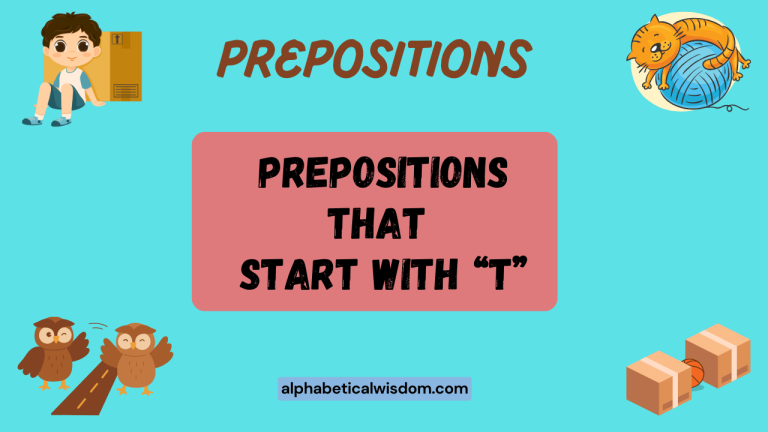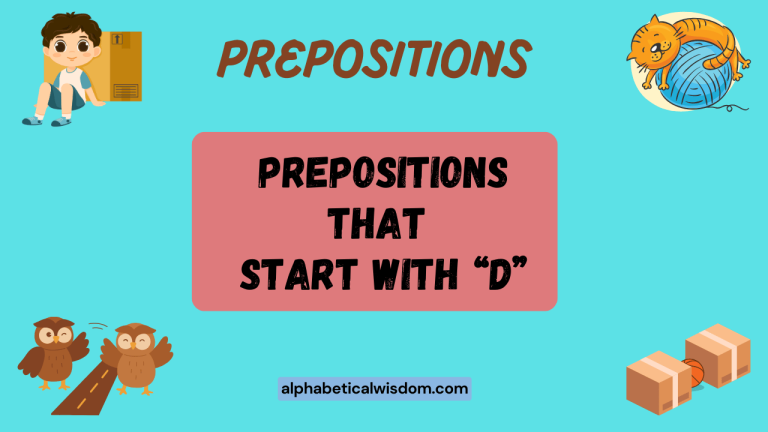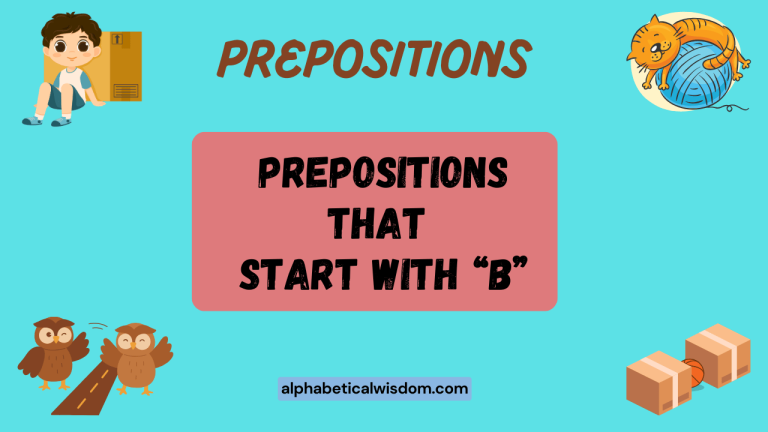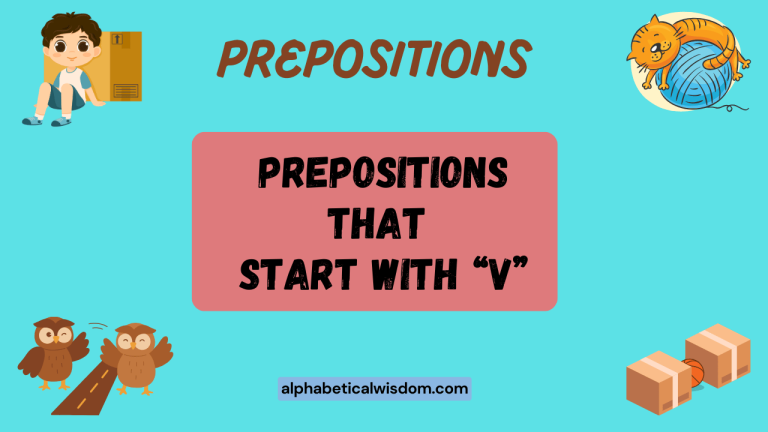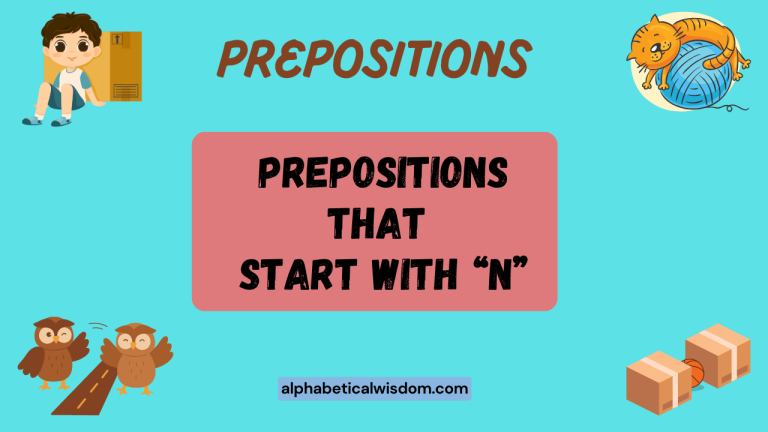Mastering Prepositions Starting with ‘O’: A Comprehensive Guide
Prepositions are essential components of the English language, acting as the glue that connects words within a sentence. They specify relationships between nouns, pronouns, and other words, indicating location, direction, time, and more.
While some prepositions are frequently used and easily recognizable, others, particularly those starting with specific letters like ‘O’, may pose a challenge to learners. Understanding and correctly using these prepositions is crucial for constructing clear, accurate, and sophisticated sentences.
This guide provides a comprehensive overview of prepositions starting with ‘O’, offering definitions, examples, usage rules, and practice exercises to help you master this aspect of English grammar.
Table of Contents
- Introduction
- Definition of Prepositions
- Structural Breakdown
- Types and Categories of Prepositions
- Examples of Prepositions Starting with ‘O’
- Usage Rules
- Common Mistakes
- Practice Exercises
- Advanced Topics
- FAQ
- Conclusion
Definition of Prepositions
A preposition is a word that connects a noun or pronoun (the object of the preposition) to other words in a sentence. It typically indicates spatial, temporal, or logical relationships. Prepositions are considered a closed class of words, meaning new prepositions are rarely added to the English language. They provide crucial context and detail, enabling more precise communication.
Prepositions can be classified based on their structure and function. Simple prepositions consist of a single word, such as on, of, and over. Compound prepositions are formed from two or more words, such as according to, because of, and in spite of. Prepositions can also be categorized by the type of relationship they express, including location, direction, time, and manner.
Structural Breakdown
The basic structure involving a preposition is the prepositional phrase. A prepositional phrase consists of a preposition followed by its object, which is typically a noun or pronoun. The object of the preposition can also be a gerund (a verb ending in -ing that functions as a noun) or a clause.
The prepositional phrase functions as an adjective or an adverb within the sentence. An adjectival phrase modifies a noun or pronoun, while an adverbial phrase modifies a verb, adjective, or another adverb.
The position of the prepositional phrase within the sentence can affect its meaning and emphasis.
Consider the following examples:
- The book on the table is mine. (Adjectival phrase modifying “book”)
- She walked to the store. (Adverbial phrase modifying “walked”)
- He is good at playing guitar. (Adjectival phrase modifying “good,” with a gerund as the object)
Types and Categories of Prepositions
Prepositions can be categorized based on the type of relationship they express. Here are some common categories:
Prepositions of Location
These prepositions indicate the position or location of something in space. Examples include on, in, at, over, under, beside, and between.
Prepositions of Direction
These prepositions indicate movement or direction. Examples include to, from, into, onto, through, across, and over.
Prepositions of Time
These prepositions indicate when something happens or its duration. Examples include on, in, at, before, after, during, and since.
Prepositions of Manner
These prepositions indicate how something is done. Examples include by, with, and in.
Prepositions of Purpose
These prepositions indicate the reason or purpose for something. Examples include for and to.
Prepositions of Relationship
These prepositions indicate a relationship between two or more things. Examples include of, with, about, and regarding.
Examples of Prepositions Starting with ‘O’
This section provides extensive examples of prepositions starting with the letter ‘O’, illustrating their various uses and meanings.
Over
The preposition “over” can indicate a position above something, movement across something, or a duration of time. It has a wide range of applications and is frequently used in everyday language.
The following table illustrates the multiple uses of “over”:
| Category | Example Sentence | Explanation |
|---|---|---|
| Position Above | The bird flew over the house. | Indicates the bird’s flight path was above the house. |
| Movement Across | He jumped over the fence. | Indicates movement from one side of the fence to the other. |
| Duration of Time | We talked over dinner. | Indicates the conversation occurred during the dinner. |
| Covering | She put a blanket over the baby. | Indicates the blanket was placed to cover the baby. |
| Dominance/Control | The king ruled over his kingdom. | Indicates the king had authority and control over his kingdom. |
| About/Concerning | They argued over money. | Indicates the subject of the argument was money. |
| More Than | The temperature was over 30 degrees. | Indicates the temperature exceeded 30 degrees. |
| Radio/Television | The news was broadcast over the radio. | Indicates the medium through which the news was transmitted. |
| Repeated Action | I told him over and over again. | Indicates a repeated action of telling. |
| Finished/Completed | The meeting is finally over. | Indicates the meeting has concluded. |
| Supervision | The manager has oversight over the project. | Indicates the manager’s responsibility for supervising the project. |
| Across a Distance | They communicated over long distances. | Indicates communication occurred despite the distance. |
| Thinking About | I need to think over your proposal. | Indicates considering or reflecting on the proposal. |
| Examining | The doctor looked over the patient’s chart. | Indicates reviewing or examining the chart. |
| During a Period | He became famous over the years. | Indicates fame developed during a period of years. |
| Hiding | The clouds hung over the city. | Indicates clouds covering the city. |
| Triumph | She triumphed over adversity. | Indicates overcoming or succeeding despite difficulties. |
| Distribution | Spread the butter over the bread. | Indicates spreading the butter to cover the bread. |
| Exceeding | The cost was over budget. | Indicates the cost exceeded the allocated budget. |
| Reviewing | Let’s go over the details again. | Indicates reviewing or repeating the details. |
| Superiority | His skill is over hers. | Indicates his skill is greater than hers. |
| Throughout | The news spread over the country. | Indicates the news spread throughout the country. |
| Avoiding | He chose to drive over the bridge. | Indicates the route taken was via the bridge. |
| Protection | They built a roof over the patio. | Indicates the roof provides protection for the patio. |
| Consideration | They pondered over the decision. | Indicates thoughtful consideration of the decision. |
| Across | The wires stretched over the field. | Indicates the wires spanned across the field. |
| Authority | She has authority over the department. | Indicates she has control and authority in the department. |
On
The preposition “on” is used to indicate a surface, a specific day or date, or a state of being. It is one of the most versatile prepositions in the English language.
The following table illustrates the multiple uses of “on”:
| Category | Example Sentence | Explanation |
|---|---|---|
| Surface | The book is on the table. | Indicates the book is resting on the surface of the table. |
| Specific Day/Date | The meeting is on Monday. | Indicates the meeting will take place on Monday. |
| Attached/Connected | The picture is on the wall. | Indicates the picture is attached to the wall. |
| About/Concerning | He wrote a book on history. | Indicates the book is about the subject of history. |
| State of Being | She is on vacation. | Indicates she is currently in a state of being on vacation. |
| Equipment | The TV is on. | Indicates the TV is in an operating state. |
| Direction | The town is on the coast. | Indicates the location of the town is along the coast. |
| Transportation | He traveled on a train. | Indicates the mode of transportation used. |
| Source of Information | I read it on the internet. | Indicates the internet was the source of the information. |
| Basis/Condition | He did it on purpose. | Indicates the action was done with intention. |
| Part of the Body | She wore a ring on her finger. | Indicates the location of the ring on her body. |
| Food | He lived on bread and water. | Indicates the type of food consumed. |
| Attacking | The dog jumped on him. | Indicates the dog jumped and made contact with him. |
| Dependence | They rely on their parents. | Indicates dependence on their parents. |
| Oath | He swore on the Bible. | Indicates an oath was taken using the Bible. |
| Payment | Buy it on credit. | Indicates the method of payment used. |
| Fire | The house is on fire. | Indicates the house is currently burning. |
| Schedule | The show is on at 8 pm. | Indicates the scheduled time for the show. |
| Medication | He is on medication. | Indicates he is currently taking medication. |
| Display | The painting is on display. | Indicates the painting is being exhibited. |
| Duty | He is on duty. | Indicates he is currently performing his duties. |
| A Diet | She is on a diet. | Indicates she is currently following a diet. |
| A Team | He is on the football team. | Indicates he is a member of the football team. |
| The Phone | She is on the phone. | Indicates she is currently speaking on the phone. |
| An Expedition | They went on an expedition. | Indicates they participated in an expedition. |
| A Trip | We are going on a trip. | Indicates that they are going to take a trip. |
Onto
The preposition “onto” indicates movement to a position on a surface. It combines the meanings of “on” and “to,” and is often used to describe actions involving climbing or placing something on a surface.
The following table illustrates the uses of “onto”:
| Category | Example Sentence | Explanation |
|---|---|---|
| Movement to a Surface | The cat jumped onto the roof. | Indicates the cat moved from a lower position to the roof. |
| Placing on a Surface | He put the books onto the shelf. | Indicates the books were placed on the shelf. |
| Becoming Aware | She caught onto the joke. | Indicates she understood or became aware of the joke. |
| Transferring | He transferred the data onto the new hard drive. | Indicates data was moved to the new hard drive. |
| Focus | Let’s move onto the next topic. | Indicates a shift in focus to the next topic. |
Of
The preposition “of” indicates relationships such as belonging, origin, or composition. It is one of the most common prepositions and plays a crucial role in expressing various connections between words.
| Category | Example Sentence | Explanation |
|---|---|---|
| Belonging | This is the house of my parents. | Indicates the house belongs to the parents. |
| Origin | She is a native of Spain. | Indicates her place of origin is Spain. |
| Composition | The cake is made of flour, sugar, and eggs. | Indicates the ingredients that compose the cake. |
| Description | A man of great courage. | Describes the man’s characteristic. |
| Quantity | A lot of people came. | Indicates a large number of people. |
Off
The preposition “off” indicates separation, removal, or a state of being away from something. It is commonly used to describe movement away from a surface or a disconnection.
| Category | Example Sentence | Explanation |
|---|---|---|
| Separation | The book fell off the table. | Indicates the book separated from the table. |
| Disconnection | Please turn off the lights. | Indicates disconnecting or switching off the lights. |
| Departure | They drove off into the sunset. | Indicates they departed or drove away. |
| Time Away | I’m taking a week off from work. | Indicates a period of absence from work. |
| Consumption | He lived off his savings. | Indicates he relied on his savings for living. |
Out
The preposition “out” indicates movement away from an enclosed space or a state of being outside. It is often used to describe actions involving exiting or being located externally.
| Category | Example Sentence | Explanation |
|---|---|---|
| Movement Away | She walked out of the room. | Indicates she moved away from inside the room. |
| External Location | The stars came out at night. | Indicates the stars became visible outside. |
| Absence | The fire went out. | Indicates the fire is no longer burning. |
| Exhaustion | They ran out of time. | Indicates they had no time remaining. |
| Discovery | The truth came out. | Indicates the truth became known. |
Outside
The preposition “outside” indicates a location that is external to a building, place, or enclosed area. It specifies that something is not within the boundaries or confines of a particular space.
| Category | Example Sentence | Explanation |
|---|---|---|
| Location | The car is parked outside the house. | Indicates the car’s position is external to the house. |
| Beyond | Outside of work, I enjoy hiking. | Indicates activities enjoyed apart or separate from work. |
Opposite
The preposition “opposite” indicates a position facing or across from something else. It implies a direct facing or contrary relationship between two things.
| Category | Example Sentence | Explanation |
|---|---|---|
| Position | The bank is opposite the library. | Indicates the bank’s position is directly across from the library. |
| Contrast | She holds the opposite view. | Indicates views that are in contrast to each other. |
Owing to
The preposition “owing to” indicates a cause or reason for something. It is used to explain why something has happened or is the case.
| Category | Example Sentence | Explanation |
|---|---|---|
| Cause | The game was canceled owing to the rain. | Indicates the rain was the reason for the game’s cancellation. |
Usage Rules
Using prepositions correctly involves understanding their specific meanings and the context in which they are used. Here are some general rules to follow:
- Choose the correct preposition: Each preposition has a specific meaning, so select the one that accurately reflects the relationship you want to express.
- Consider the context: The meaning of a preposition can vary depending on the context of the sentence.
- Avoid ending sentences with prepositions: While this rule is often relaxed in modern English, it is generally considered more formal to avoid ending a sentence with a preposition. Instead, try to rephrase the sentence.
- Use the correct preposition in idioms: Many common expressions use specific prepositions. Learn these idioms to ensure correct usage.
Common Mistakes
One common mistake is confusing prepositions with adverbs. For example, using “off” as a preposition versus an adverb.
Another common error is using the wrong preposition in a specific context. For example, saying “I’m good in math” instead of “I’m good at math.” Pay attention to these common mistakes and practice using the correct prepositions.
Here are some examples of common mistakes and their corrections:
| Incorrect | Correct | Explanation |
|---|---|---|
| I’m good in math. | I’m good at math. | The correct preposition to use with “good” when referring to a skill is “at.” |
| She is afraid from spiders. | She is afraid of spiders. | The correct preposition to use with “afraid” is “of.” |
| He arrived to the airport. | He arrived at the airport. | The correct preposition to use with “arrive” when referring to a specific location is “at.” |
| The cat jumped of the table. | The cat jumped off the table. | The correct preposition “off” indicates movement away from a surface. |
Practice Exercises
Test your understanding of prepositions starting with ‘O’ with these exercises.
Exercise 1: Fill in the Blanks
Fill in the blanks with the correct preposition starting with ‘O’.
| Question | Answer |
|---|---|
| 1. The picture is hanging _______ the wall. | on |
| 2. The cat jumped _______ the fence. | over |
| 3. She is a native _______ France. | of |
| 4. He took a week _______ from work. | off |
| 5. The children ran _______ of the house. | out |
| 6. The bank is _______ the grocery store. | opposite |
| 7. The game was delayed _______ the weather. | owing to |
| 8. The cat climbed _______ the roof. | onto |
| 9. The meeting went _______ time. | over |
| 10. She is currently _______ the phone. | on |
Exercise 2: Correct the Sentence
Correct the sentences with the incorrect preposition usage.
| Question | Answer |
|---|---|
| 1. I am good in playing soccer. | I am good at playing soccer. |
| 2. She is afraid from the dark. | She is afraid of the dark. |
| 3. He arrived to the party late. | He arrived at the party late. |
| 4. The book fell of the shelf. | The book fell off the shelf. |
| 5. They walked out from the building. | They walked out of the building. |
| 6. The store is opposite to the park. | The store is opposite the park. |
| 7. The concert was cancelled owing of rain. | The concert was cancelled owing to rain. |
| 8. She climbed on the ladder onto the roof. | She climbed on the ladder to the roof. |
| 9. The teacher went over on the lesson. | The teacher went over the lesson. |
| 10. He is currently on the vacation. | He is currently on vacation. |
Advanced Topics
For advanced learners, understanding the nuances of prepositional usage requires deeper exploration. This includes studying prepositional idioms, phrasal verbs, and the subtle differences in meaning that can arise from using different prepositions in similar contexts.
Additionally, analyzing the historical evolution of prepositions can provide insight into their current usage.
Furthermore, advanced learners can benefit from studying the use of prepositions in different registers of English, such as formal writing, informal conversation, and technical communication. Each register may have its own preferred prepositions and conventions.
An understanding of these nuances is essential for effective communication in a variety of contexts.
FAQ
Here are some frequently asked questions about prepositions:
- What is a preposition?
A preposition is a word that connects a noun or pronoun to other words in a sentence, indicating relationships such as location, direction, time, or manner. It forms a prepositional phrase, which functions as an adjective or adverb.
- How do I identify a preposition in a sentence?
Look for words that typically precede a noun or pronoun and indicate a relationship between that noun/pronoun and other parts of the sentence. Common prepositions include on, in, at, to, from, over, and of.
- What is the object of a preposition?
The object of a preposition is the noun or pronoun that follows the preposition and completes the prepositional phrase. For example, in the phrase “on the table,” “table” is the object of the preposition “on.”
- Can a prepositional phrase function as an adjective?
Yes, a prepositional phrase can function as an adjective by modifying a noun or pronoun. For example, in the sentence “The book on the table is mine,” the phrase “on the table” modifies the noun “book.”
- Can a prepositional phrase function as an adverb?
Yes, a prepositional phrase can function as an adverb by modifying a verb, adjective, or another adverb. For example, in the sentence “She walked to the store,” the phrase “to the store” modifies the verb “walked.”
- Is it grammatically incorrect to end a sentence with a preposition?
While traditionally discouraged, ending a sentence with a preposition is now widely accepted in informal English. However, in formal writing, it is generally better to rephrase the sentence to avoid ending with a preposition.
- What are some common prepositional idioms?
Prepositional idioms are fixed expressions that use specific prepositions. Examples include “in spite of,” “according to,” “by means of,” and “on behalf of.” These idioms should be learned as complete units.
- How can I improve my understanding of prepositions?
Practice using prepositions in different contexts, read widely to observe how they are used in various types of writing, and pay attention to common prepositional idioms. Consulting grammar resources and seeking feedback on your writing can also be helpful.
- What’s the difference between ‘on’ and ‘onto’?
‘On’ indicates a position on a surface, while ‘onto’ indicates movement to a position on a surface. For example, ‘The book is on the table’ vs. ‘The cat jumped onto the table’.
- When should I use ‘over’ versus ‘above’?
‘Over’ often implies covering or movement across, while ‘above’ simply indicates a higher position. ‘The plane flew over the city’ suggests movement, while ‘The clouds are above us’ indicates position.
Conclusion
Mastering prepositions, especially those starting with ‘O’, is a vital step in achieving fluency and accuracy in English. Understanding their various meanings, usage rules, and common idioms allows for more precise and effective communication.
By studying the examples and completing the practice exercises in this guide, you can significantly improve your understanding and usage of prepositions. Remember that consistent practice and exposure to the English language are key to mastering this essential aspect of grammar.
Continue to explore the nuances of prepositions through reading, writing, and engaging with native speakers. Pay attention to how prepositions are used in different contexts and be mindful of common mistakes.
With dedication and practice, you can confidently use prepositions to express your ideas clearly and accurately. Keep practicing these skills and you will find your overall English proficiency increases over time.
